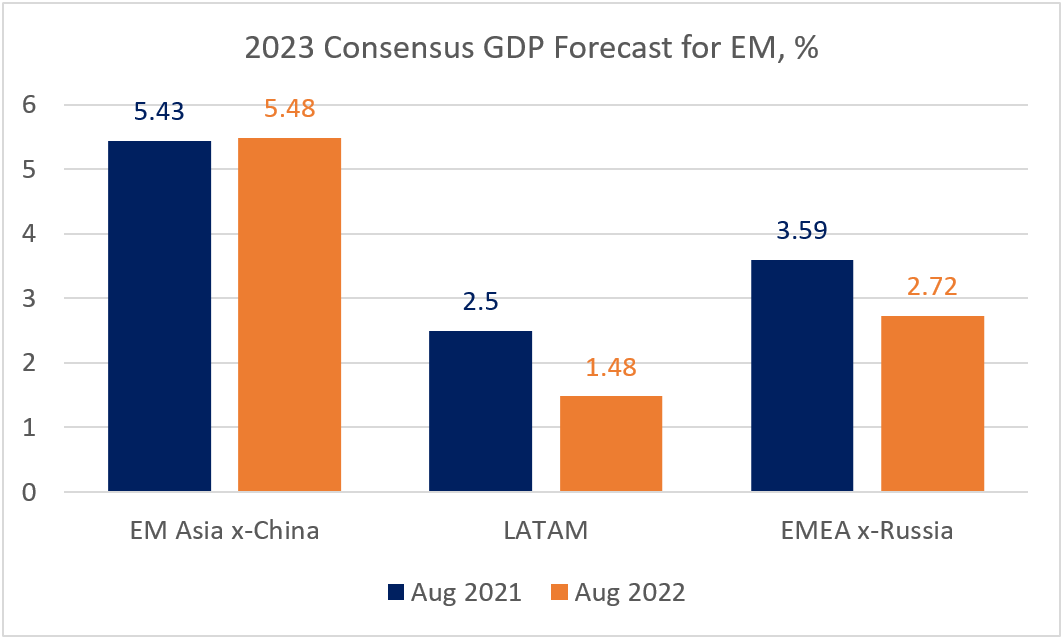Ildo Frazao
EM Rate Hike Frontloading
Emerging markets (EM) Asia’s inflation is running hot, while the growth outlook ex-China is still better than in other EM regions (see chart below). This explains why regional central banks are powering ahead with frontloaded rate hikes. India surprised again today on the hawkish side, delivering a larger than expected 50bps rate hike. The above-consensus inflation print in the Philippines suggests that the central bank and the new governor will deliver another large rate hike in August. And Indonesia’s faster than expected Q2 GDP growth (5.44% year-on-year) will test the central bank’s resolve to remain on hold at the next meeting. Perhaps the most intriguing monetary policy case in the region is the Bank of Thailand. The country’s inflation is 3+ standard deviations higher than the 5-year trend, but the much-anticipated liftoff is yet to materialize. Today’s inflation release (July) was a touch lower than expected, but it is high enough to pave the way for the inaugural rate hike next week (some brave souls even expect a 50bps move). The hawkish pressure on Asian central banks – most of which were latecomers to the current cycle – might increase following today’s surprisingly strong labor report in the U.S., which can lead to more tightening by the U.S. Federal Reserve (Fed).
Speed of EM Policy Normalization
By contrast, we keep getting more dovish surprises in Central Europe – even though headline inflation is in mid- and high-teens. Yesterday’s policy rate pause in the Czech Republic was followed by a smaller than expected rate increase in Romania (+75bps). Hungary’s tightening “surge” looks like the exception rather than the rule. One possible explanation for Central Europe’s dovish pivot is the rapidly deteriorating near-term growth outlook (H2 growth “cliff”). The latest activity surveys in Poland and the Czech Republic showed a sharp move deeper into contraction zone, and central banks believe this can help to cool domestic inflation pressures going forward. The local bond market, however, might be less forgiving if it thinks central banks are falling behind the curve.
EM Rate Hikes and Inflation Pressures
Where does this leave LATAM? Brazil’s slower pace of tightening is well-deserved – the central bank was the hiking pioneer in the current cycle, and it hiked super-aggressively. But as regards Brazil’s regional peers, the picture is more nuanced. Today’s sizable upside inflation surprise in Colombia – July inflation accelerated to 10.21% year-on-year from 9.67% in June, and core CPI jumped to 7.29% year-on-year – screams “Hike, baby, hike!” even after a sizable +150bps move a week ago. Chile’s decision to re-instate currency interventions – which worked brilliantly – can help to reduce price pressures, but the next inflation print (on August 8) will be key. Stay tuned!
Chart at a Glance: Downside Growth Revisions – Some EM Regions Are More Immune
VanEck Research; Bloomberg LP
PMI – Purchasing Managers’ Index: economic indicators derived from monthly surveys of private sector companies. A reading above 50 indicates expansion, and a reading below 50 indicates contraction; ISM – Institute for Supply Management PMI: ISM releases an index based on more than 400 purchasing and supply managers surveys; both in the manufacturing and non-manufacturing industries; CPI – Consumer Price Index: an index of the variation in prices paid by typical consumers for retail goods and other items; PPI – Producer Price Index: a family of indexes that measures the average change in selling prices received by domestic producers of goods and services over time; PCE inflation – Personal Consumption Expenditures Price Index: one measure of U.S. inflation, tracking the change in prices of goods and services purchased by consumers throughout the economy; MSCI – Morgan Stanley Capital International: an American provider of equity, fixed income, hedge fund stock market indexes, and equity portfolio analysis tools; VIX – CBOE Volatility Index: an index created by the Chicago Board Options Exchange (CBOE), which shows the market’s expectation of 30-day volatility. It is constructed using the implied volatilities on S&P 500 index options.; GBI-EM – JP Morgan’s Government Bond Index – Emerging Markets: comprehensive emerging market debt benchmarks that track local currency bonds issued by Emerging market governments; EMBI – JP Morgan’s Emerging Market Bond Index: JP Morgan’s index of dollar-denominated sovereign bonds issued by a selection of emerging market countries; EMBIG – JP Morgan’s Emerging Market Bond Index Global: tracks total returns for traded external debt instruments in emerging markets.
The information presented does not involve the rendering of personalized investment, financial, legal, or tax advice. This is not an offer to buy or sell, or a solicitation of any offer to buy or sell any of the securities mentioned herein. Certain statements contained herein may constitute projections, forecasts and other forward looking statements, which do not reflect actual results. Certain information may be provided by third-party sources and, although believed to be reliable, it has not been independently verified and its accuracy or completeness cannot be guaranteed. Any opinions, projections, forecasts, and forward-looking statements presented herein are valid as the date of this communication and are subject to change. The information herein represents the opinion of the author(s), but not necessarily those of VanEck.
Investing in international markets carries risks such as currency fluctuation, regulatory risks, economic and political instability. Emerging markets involve heightened risks related to the same factors as well as increased volatility, lower trading volume, and less liquidity. Emerging markets can have greater custodial and operational risks, and less developed legal and accounting systems than developed markets.
All investing is subject to risk, including the possible loss of the money you invest. As with any investment strategy, there is no guarantee that investment objectives will be met and investors may lose money. Diversification does not ensure a profit or protect against a loss in a declining market. Past performance is no guarantee of future performance.
Editor’s Note: The summary bullets for this article were chosen by Seeking Alpha editors.


Be the first to comment